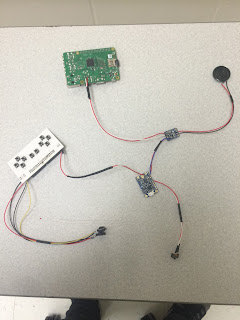So I figured out what was wrong with my screen and got it to work. Early last week I did a fresh install of Raspbian (I said this in my last post), and the screen worked like it did originally. I then tried to run EmulationStation on it from the terminal (clicking on the executable did not work), but it said that there was an error using shared files. I updated the SDL files I had and it still didn't work. Later on in the week I tried running EmulationStation from the terminal, and it worked! "Great," I thought, "now it should show up on the screen!" PSYCH! It showed up on the monitor I was using through HDMI...
I went back to Google and looked for some help. Conveniently, I was brought back to the
guide that messed up my screen in the first place, or so I thought. This time I decided to read a little about what
fbcp (what I installed last time) does. I know, a CRAZY idea. So apparently, fbcp copies the main screen (what's seen on the HDMI display) onto the PiTFT screen. The reason why it wasn't working last time was because I set the display to show on the PiTFT. SO since the HDMI display was black, it showed black on the PiTFT as well.
To fix this I changed the file where it tells the Pi which screen to display on. I will put a picture of the code later with a brief description of what didn't work and what did.
Stay tuned...
***UPDATE***
The two photos above show the only two ways I was able to display something on my Pi. In the first photo, the desktop shows on the screen, but there a couple of things wrong with it. First, everything was trying to fit on the small 320X240 display so icons were cluttered. It was very annoying to get to the terminal, let along the applications I wanted to start. In addition to that, the games would still show up on the HDMI display. Lastly, it was upside down... And the second picture...well I'm sure you can tell what's wrong. To switch the two I had the change the line Option "fbdev" "/dev/...." The fb0 option set it to the HDMI display and the fb1 set it to the PiTFT.
Once I installed fbcp and set the right screen to display, I got the results I wanted. The PiTFT screen wasn't cluttered and was turned upright, and as an added bonus, I could show things on the HDMI display and PiTFT.

 I first soldered the header box and buttons to my PCB. Then I connected the speaker to the amp by tinning the wires and connecting it to the positive and negative pins on the amp. Afterwards I wired the amp to the PowerBoost. This is how the amp is supplied power. I also connected the switch. Since I was DYING to see if I was doing this right, I took a break from soldering to put in the battery. I flipped the switch and the light came on! After this boost of confidence, I continued soldering. I soldered wires to the two audio pins on the Pi, and then connected them to the amp. This is how the speaker will play the sound. Lastly, I connected the shoulder buttons to the gamepad, and the gamepad to the PowerBoost.
I first soldered the header box and buttons to my PCB. Then I connected the speaker to the amp by tinning the wires and connecting it to the positive and negative pins on the amp. Afterwards I wired the amp to the PowerBoost. This is how the amp is supplied power. I also connected the switch. Since I was DYING to see if I was doing this right, I took a break from soldering to put in the battery. I flipped the switch and the light came on! After this boost of confidence, I continued soldering. I soldered wires to the two audio pins on the Pi, and then connected them to the amp. This is how the speaker will play the sound. Lastly, I connected the shoulder buttons to the gamepad, and the gamepad to the PowerBoost.








